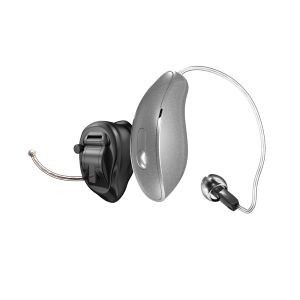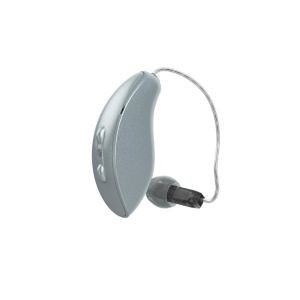
Head of Online Medical Content

Audiology Expert

Widex SmartRIC vs The New Allure Hearing Aids
What hasn't changed, and what has improved?
Overview | What they share | Edge AI | Omega AI | A comparison | Key takeaways | Conclusion
Latest Hearing Aid UK Update: 14/11/2025
Overview
If you're weighing up Starkey's Edge AI against the newer Omega AI, you're in quite a fortunate position - both are genuinely excellent hearing aids that will serve most people brilliantly.
The question isn't whether one works and the other doesn't, but rather whether the additional capabilities of the Omega AI justify the extra investment for your particular situation.
What they share
Let's start with what they share, because there's quite a lot. Both Edge AI and Omega AI are premium hearing-aid platforms offering top-tier connectivity, rechargeable options, app control, and AI-driven sound processing that actually makes a difference to how you hear in challenging environments.
Both support Bluetooth Low Energy streaming for modern devices, which means reliable connections that don't drain your battery. They also include "Edge Mode" features that allow you to manually boost speech clarity when automatic processing needs a bit of extra help - particularly useful in restaurants or meetings where things get genuinely noisy.
In short, both platforms address everyday hearing loss needs, streaming requirements, and challenging listening situations brilliantly. The difference lies in how much additional innovation and future-proofing you'll get with the Omega version when things get very demanding.

Edge AI: Premium performance that works
Here's what makes the Edge AI platform stand out. It uses a deep neural-network (DNN) based processing engine in its G2 Neuro Processor, which Starkey claims offers 100 times more processing power compared to their earlier Genesis AI generation.
That's not just impressive-sounding numbers - it translates to very strong improvements in speech recognition and noise reduction in real-world situations.
The Edge Mode+ feature gives you on-demand boosting for speech clarity when the automatic mode is being taxed - think crowded restaurants, large meetings, or busy shops. It's there when you need it, unobtrusive when you don't.
Battery life is genuinely impressive - rechargeable models offer up to 51 hours, depending on the specific model you choose. That's several days of use for most people, which means you're not constantly worrying about charging or running out of power at inconvenient moments.
Connectivity is robust with Bluetooth LE and streaming support that works reliably with modern smartphones. The Edge AI is excellent for most users who face challenging hearing environments and want top-tier features without necessarily needing the absolute latest generation.
The limitation? It's no longer the newest platform (Omega AI is more recent), so if you specifically need the very latest technology or health-monitoring extras, the Edge AI doesn't include those features. For many people, that won't matter at all.

Omega AI: The breakthrough flagship
Now for the Omega AI, which is where things get really interesting. Starkey describes this as their "breakthrough" flagship platform with significantly upgraded capabilities, and frankly, they're not overselling it. This isn't just an incremental update - there are some genuinely new features here.
The Omega AI introduces "DNN 360" directionality system, which is built to give you up to 28% better speech intelligibility in challenging environments and up to 8 dB improvement in signal-to-noise ratio for spatial awareness.
In practical terms, this means you can better understand speech coming from any direction whilst maintaining awareness of your acoustic surroundings - rather like having very selective attention that still keeps you connected to what's happening around you.
Here's where the Omega AI diverges significantly from the Edge AI: it adds health-monitoring features, including respiratory-rate monitoring, fall-detection, and balance training via the app.
Whether these features matter to you depends entirely on your circumstances, but for people concerned about falls or who want to monitor their overall health, having these capabilities built into their hearing aids is genuinely useful rather than gimmicky.
Connectivity is future-proofed with Bluetooth LE Audio, Auracast readiness, and generative AI support in the My Starkey app for on-the-go adjustments. Battery life remains impressive at around 51 hours for some models, with enhanced waterproof and wear-resistance for real-world durability.
The Omega AI is ideal for users who demand the most advanced features, find themselves frequently in extremely noisy or complex listening situations, and value the extra health-tracking functionality. It's the very top of Starkey's range.
The limitation? For many users, the incremental gain over Edge AI might be marginal in everyday moderate environments. It's also likely to cost more, and you'll still need excellent fitting and tuning to unlock the full potential - premium technology doesn't compensate for inadequate audiological care.
Choosing between them - Practical guidance
If your lifestyle involves very challenging listening environments - you're frequently in very noisy restaurants, large meetings, open-plan workspaces, travelling regularly, streaming music and TV throughout the day, connecting multiple devices - then the Omega AI offers meaningful upgrades in speech clarity, spatial awareness, and connectivity.
If your listening environments are more moderate - typical home and office life, normal social outings, occasional streaming - then the Edge AI will very likely serve you extremely well and give you excellent hearing quality without paying for the absolute top tier. Honestly, for many people, this represents outstanding value.
Consider the extras carefully. If you're interested in health monitoring features like balance tracking, respiratory rate monitoring, and fall detection, or if you want future-proof connectivity with Auracast and generative AI via the app, then the Omega AI has clear advantages. If these features don't particularly interest you, you're paying for capabilities you won't use.
Omega AI vs Edge AI comparison chart
| Feature | Edge AI | Omega AI |
|---|---|---|
| Positioning | Premium | Breakthrough Flagship |
| Processor | G2 Neuro Processor (100× more power vs Genesis AI) | Latest generation (significantly upgraded) |
| AI Processing | Deep Neural Network (DNN) | DNN 360 directionality system |
| Speech Intelligibility | Excellent | Up to 28% better (in challenging environments) |
| Signal-to-Noise Ratio | Very good | Up to 8 dB improvement (for spatial awareness) |
| Edge Mode | Edge Mode+ (on-demand speech boost) | Edge Mode+ (on-demand speech boost) |
| Battery Life (rechargeable) | Up to 51 hours | Up to 51 hours |
| Connectivity | Bluetooth LE (reliable streaming) | Bluetooth LE Audio (+ Auracast ready) |
| App Features | My Starkey app (standard controls) | My Starkey app (+ generative AI support) |
| Health Monitoring | Not included | ✓ Respiratory rate ✓ Fall detection ✓ Balance training |
| Durability | Excellent | Enhanced waterproof/wear-resistance |
| Noise Reduction | Very strong improvements | Enhanced with DNN 360 |
| Best For | Challenging environments, demanding users, excellent value | Extremely noisy environments, health-conscious users, future-proofing |
| Value Proposition | Outstanding value - fulfils 90%+ of needs | Latest technology - best of the best with health extras |
The most important factor
Here's something that often gets overlooked - even the best hearing aid will underperform without proper audiologist fitting, tuning to your specific hearing loss, and regular follow-up appointments. This is where our service model makes a genuine difference.
We offer free home visits across the UK with over 200 qualified audiologists who can fit and programme your Starkey hearing aids in the environment where you'll actually use them most. Our lifetime aftercare is included in the price, so as your hearing changes or your needs evolve, we'll adjust your aids at no additional cost.
Our 60-day money-back guarantee means you can try either platform without risk. If the hearing aids aren't right after proper fitting and adjustment, we'll refund everything - no 10% retention fees or awkward questions.
Key takeaways
Edge AI = A superb premium hearing aid with strong AI-driven sound processing, excellent battery life and connectivity, very good for the most demanding users. Outstanding value.
Omega AI = The next level up with the newest generation technology, enhanced directionality (DNN 360), advanced health-tracking, and very strong future-proofing for connectivity. For those who want the best of the best.
For many users, the Edge AI will fulfil 90% or more of their needs beautifully. The Omega AI gives you that extra margin of performance and features for those who genuinely need it - or simply want the most advanced option available.
Conclusion and next steps
The best hearing aid is only as good as how it's fitted and tuned to your specific hearing loss and lifestyle. Our independent audiologists can assess your hearing, discuss your daily listening situations, and recommend which platform - and which technology level within that platform - makes sense for you.
Book a free hearing test and consultation, whether at home or in one of our clinics across the UK. We'll take the time to understand what you actually need and ensure you get hearing aids that improve your daily life rather than just impressive specifications on paper.
Why Choose Us?
- FREE Hearing Tests
- Best Hearing Aids and Prices
- FREE Aftercare for Life
- FREE Home Visits
- 200+ Local Audiologists
- 60 Day Money Back Guarantee
Starkey Omega AI vs Edge AI hearing aids
Not sure which option is right for you?
Our independent audiologists can assess your hearing and lifestyle to recommend the best choice - Edge AI or Omega AI - with no obligation and no sales pressure.
Book a free hearing test at home or in a clinic. You'll get honest advice, lifetime aftercare included, and a 60-day money-back guarantee.
We'll help you decide which platform genuinely suits your needs and budget.
Other hearing aid technology articles you might like...
 What hearing aid features do I actually need?
What hearing aid features do I actually need?  Speech Enhancement in Hearing Aids
Speech Enhancement in Hearing Aids  Spatial Awareness in Hearing Aids
Spatial Awareness in Hearing Aids Watch the Starkey Omega AI hearing aid video below
Our specialist service includes:
Do not spend hundreds of pounds without getting a second opinion from us.
Please call us on 0800 567 7621
 Not only are the prices great, but the service is fantastic! Many thanks to your team.
Not only are the prices great, but the service is fantastic! Many thanks to your team.What's included in our hearing aid prices?
Common FAQs about hearing aids and hearing loss
In general, any audiologist will always recommend to you the hearing aid model that best suits your needs. Here is a useful checklist to make sure that is the case.
- Audiologist's level of knowledge: The audiologist you have seen will hopefully have a wide knowledge of all available hearing aids; however, some will only be familiar with a small number of brands and, therefore, may not really be in a position to know which model is the best for you. It is OK to challenge their recommendation and ask them to justify why this particular brand is the one for you.
- Do research: Read about the hearing aid that was recommended. Does it seem like it will suit your lifestyle? Does it have more or fewer features than you need?
- Be aware of sales targets: Many high street retailers have specific tie-ins to a particular manufacturer/brand. The hearing aid they have suggested may still be the correct one for you, but do your research so that you know why they might have recommended it.
If you have significant hearing loss in both ears, you should be wearing two hearing aids. Here are the audiological reasons why:
Localisation: The brain decodes information from both ears and compares and contrasts them. By analysing the minuscule time delays as well as the difference in the loudness of each sound reaching the ears, the person is able to accurately locate a sound source.
Simply put, if you have better hearing on one side than the other, you can't accurately tell what direction sounds are coming from.
Less amplification is required: A phenomenon known as “binaural summation” means that the hearing aids can be set at a lower and more natural volume setting than if you wore only one hearing aid.
Head shadow effect: High frequencies, the part of your hearing that gives clarity and meaning to speech sounds, cannot bend around your head. Only low frequencies can. Therefore, if someone is talking on your unaided side, you are likely to hear that they are speaking, but be unable to tell what they have said.
Noise reduction: The brain has its own built-in noise reduction, which is only really effective when it is receiving information from both ears. If only one ear is aided, even with the best hearing aid in the world, it will be difficult for you to hear in background noise as your brain is trying to retain all of the sounds (including background noise) rather than filtering them out.
Sound quality: We are designed to hear in stereo. Only hearing from one side sounds a lot less natural to us.
Fancy some further reading on this topic? You can read about why two hearing aids are better than one in our article, hearing aids for Both Ears, here
For most people, the main benefit of a rechargeable hearing aid is simple convenience. We are used to plugging in our phones and other devices overnight for them to charge up. Here are some other pros and cons:
For anybody with poor dexterity or issues with their fingers, having a rechargeable aid makes a huge difference, as normal hearing aid batteries are quite small and some people find them fiddly to change.
One downside is that if you forget to charge your hearing aid, then it is a problem that can't be instantly fixed. For most, a 30-minute charge will get you at least two or three hours of hearing, but if you are the type of person who is likely to forget to plug them in regularly, then you're probably better off with standard batteries.
Rechargeable aids are also a little bit bigger and are only available in Behind-the-Ear models.
Finally, just like with a mobile phone, the amount of charge you get on day one is not going to be the same as you get a few years down the line. Be sure to ask what the policy is with the manufacturer's warranty when it comes to replacing the battery.
For most people, the answer is yes. But it's never that simple.
The majority of hearing problems affect the high frequencies a lot more than the low ones. Therefore, open fitting hearing aids sound a lot more natural and ones that block your ears up can make your own voice sound like you are talking with your head in a bucket. Therefore, in-ear aids tend to be less natural.
However, the true answer is we can't tell until we have had a look in your ears to assess the size of your ear canal, and until we have tested your hearing to see which frequencies are being affected.
People with wider ear canals tend to have more flexibility, also there are open fitting modular CIC hearing aids now that do not block your ears.
There is also the age-old rule to consider, that a hearing aid will not help you if it's sat in the drawer gathering dust. If the only hearing aid you would be happy wearing is one that people can't see, then that's what you should get.
Most people can adapt to any type of hearing aid, as long as they know what to expect. Have an honest conversation with your audiologist as to what your needs are.
Generally speaking, six or more. Unless it's none at all. The number of channels a hearing aid has is often a simplistic way an audiologist will use to explain why one hearing aid is better than another, but channels are complex, and it is really not that straightforward. Here are some reasons why:
Hearing aids amplify sounds of different frequencies by different amounts. Most people have lost more high frequencies than low, and therefore need more amplification in the high frequencies. The range of sounds you hear is split into frequency bands or channels, and the hearing aids are set to provide the right amount of hearing at each frequency level.
Less than six channels, and this cannot be done with much accuracy, so six is the magic number. However, a six-channel aid is typically very basic with few other features and is suitable only for hearing a single speaker in a quiet room. The number of channels is not what you should be looking at; it's more the rest of the technology that comes with them.
As a final note, different manufacturers have different approaches. One method is not necessarily better than any other. For example, some manufacturers have as many as 64 channels in their top aids. Most tend to have between 17 and 20. One manufacturer has no channels at all.
Manufacturer's warranties typically last between 2-5 years, depending on the brand and model, and cover defects in materials and workmanship. This includes repairs for component failures, electronic malfunctions, and manufacturing defects, but excludes damage from misuse, accidents, or normal wear. Most manufacturers also include loss and damage insurance for the first year.
We handle all warranty claims on your behalf, liaising with manufacturers and ensuring you get replacement devices quickly when needed. This comprehensive warranty coverage, combined with our lifetime aftercare, gives you complete peace of mind.
Our hearing tests are completely free, whether at our clinics or in your home. Unlike other providers who charge £30-£100 for home visits, we believe hearing healthcare should be accessible without financial barriers. Our comprehensive assessments include examination by a registered audiologist, audiogram results, and personalised recommendations.
All testing, future adjustments, and ongoing support are included at no extra cost. While NHS tests are also free, typical 6-week waiting periods often lead people to seek immediate private testing. We provide prompt, professional assessments that fit your schedule and budget.
Yes, we offer completely free home visits throughout the UK, and this service is included in our prices with no additional charges. Home visits are particularly valuable for people with mobility issues, busy schedules, or those who simply prefer the comfort and convenience of their own environment.
Our audiologists can conduct full hearing tests, fit hearing aids, and provide ongoing support in your home. This service sets us apart from many providers who either don't offer home visits or charge extra for them.
We can offer prices up to 40% lower than high street retailers because of our business model. As a network of 200+ independent audiologists, we don't have the massive overheads of large retail chains - no expensive high street premises, no sales targets pushing audiologists to sell the most expensive options, and no costly marketing campaigns.
However, we maintain the same buying power as the big chains because we purchase on behalf of our entire nationwide network. This means you get access to the same premium hearing aids with professional service, but at genuinely competitive prices.
We offer a comprehensive 60-day money-back guarantee, which gives you twice the industry standard time to properly assess whether your hearing aids are right for you. This extended period recognises that adjusting to hearing aids takes time, and your brain needs several weeks to adapt to the amplified sounds.
Unlike many providers who offer just 30 days, we believe 60 days gives you the confidence to test your hearing aids in all the situations that matter to you - from quiet conversations at home to busy restaurants and outdoor activities.
Other pages you might find useful
Ask the Experts
6 Morton Lane
Walkwood
Redditch
Worcestershire
B97 5QA
Latest Launch
When we refer to a product as 'Latest Launch', we mean it is the latest to be released on the market.
New
When we refer to a product as 'New', we mean that the product is the newest hearing aid model on the market.
When we refer to a product as 'Superseded', we mean that there is a newer range available which replaces and improves on this product.
Older Model
When we refer to a product as an 'Older Model', we mean that it is has been superseded by at least two more recent hearing aid ranges.
